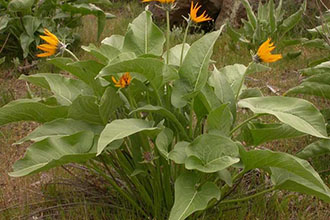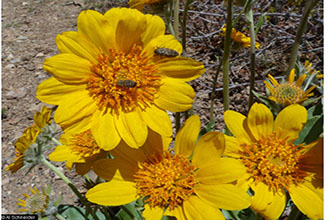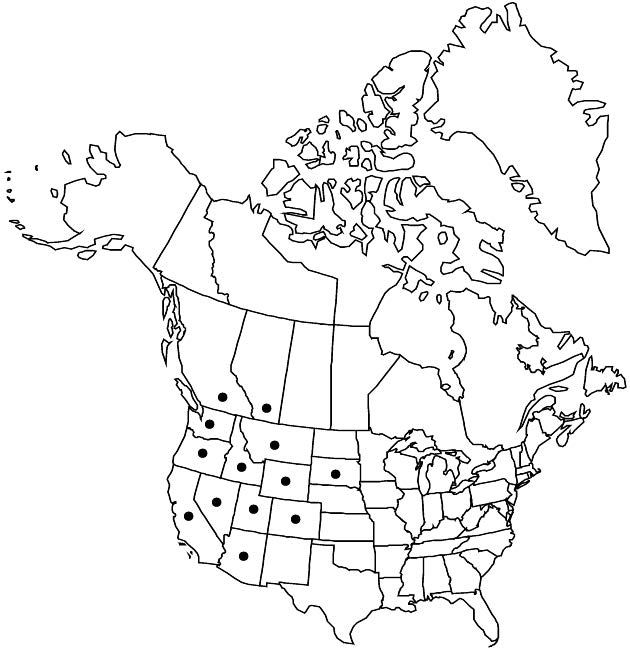USFS Plant Database
Arrowleaf balsamroot is a cool-season, large, long-lived, native, perennial forb 0.3-0.6 m in height. Basal leaves are cordate to sagittate in outline with entire margins and wooly pubescence. They arise from a branched, underground caudex to form dense rosettes...Arrowleaf balsamroot has a taproot that sometimes reaches a diameter of 10 cm and an extreme depth of 2.7 m.
Arrowleaf balsamroot is listed as part of the vegetation in a climax interior ponderosa pine (Pinus ponderosa var. scopulorum) community on the east slope of the Cascade Mountains, Blue Mountains and Northern Rocky Mountains. An edaphic climax type in Colorado of Wyoming big sagebrush/bluebunch wheatgrass includes arrowleaf balsamroot... In a study of grasslands of lower British Columbia, Tisdale describes arrowleaf balsamroot as "found more commonly" in the mid-seral stage of needlegrass (Stipa spp.)-bluegrass as grasslands previously heavily grazed progressed to the climax stage of bluebunch wheatgrass-rough fescue (F. altaica)... Weaver, in an early study of plant succession in eastern Washington and adjacent Idaho, lists arrowleaf balsamroot as an "invader" in the transition from the bunchgrass-rimrock vegetation type to "prairie" vegetation at the top of canyons.
Arrowleaf balsamroot has been traditionally been used by First Nation peoples for many uses including food and medicine. Native Americans in Washington State used the "sprouts" of arrowleaf balsamroot in their diet. These shoots are high in ascorbic acid (13.75 mg/g). Native Canadians of British Columbia also ate the sprouts along with the starchy roots. In addition, the plant was used to treat stomachache, headache, colds, fever, sore throat, toothache, wounds, insect bites, and swellings... Houston and others state Native Americans in Wyoming ate the young stalks, roots and seeds of arrowleaf balsamroot. Members of the Salish, Kootenai, and Nez Perce tribes peeled arrowleaf balsamroot's young, immature flower stems and ate the tender inner portion raw, like celery. The Nez Perce ate the seeds. Salish used the large, coarse leaves as a poultice for burns and drank tea brewed from the roots for tuberculosis, whooping cough, increased urine, and as a cathartic. Members of the Kootenai tribe boiled the roots and applied the infusion as a poultice for wounds, cuts, and bruises.
The currently accepted scientific name of arrowleaf balsamroot is Balsamorhiza sagittata Pursh (Nutt.) (Asteraceae). Arrowleaf balsamroot hybridizes with Carey's balsamroot (B. carreyana), Hooker balsamroot (B. hookeri), hoary balsamroot (B. incana), and toothed balsamroot (B. serata).
Arrowleaf balsamroot is commonly associated with various sagebrush taxa including basin big sagebrush (A. t. ssp. tridentata), mountain big sagebrush (A. t. ssp. vaseyana), mountain silver sagebrush (A. cana ssp. viscidual), and threetip sagebrush (A. tripartita). Its occurrence in the big sagebrush habitats is dependent on annual precipitation. Strong and others list arrowleaf balsamroot as occurring in Wyoming big sagebrush (A.t. ssp wyomingensis)/bluebunch wheatgrass habitat type in Colorado.
In native stands of the northern Intermountain Region and the Pacific Northwest arrowleaf balsamroot is commonly associated with Idaho fescue, bluebunch wheatgrass, western (J. occidentalis) and Utah (J. osteosperma) junipers, ponderosa pine and the mountain shrub complex. (Plant Database)


